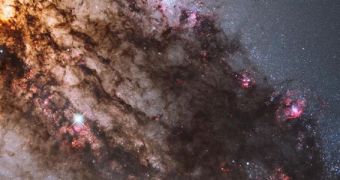In this iconic Hubble image, taken by the NASA telescope in July 2010, the massive elliptical galaxy called Centaurus A is revealed in all it splendor. Its unusual appearance is caused by the dark lanes of cosmic dust that can be seen throughout the image.
What is especially interesting about this view, as opposed to similar ones collected on other occasions, is that it stretches from near-infrared to the ultraviolet portion of the electromagnetic spectrum, revealing details that have thus far remained hidden.
Areas of intense stellar formation – in bright blue – can be seen throughout the galaxy, indicating that it is still producing young stars at a frantic pace. At the same time, Hubble also produced interesting data about the central portions of the elliptical galaxy.
The thing that has always attracted astronomers to Centaurus A is the fact that it's an active galactic nucleus, the closest such structure to Earth ever discovered. The galaxy lies about 11 million light-years from us, and its core is powered by a supermassive black hole.

 14 DAY TRIAL //
14 DAY TRIAL //